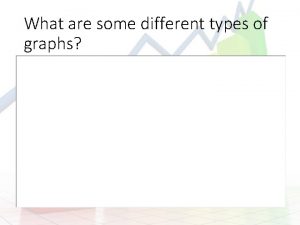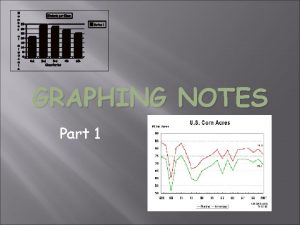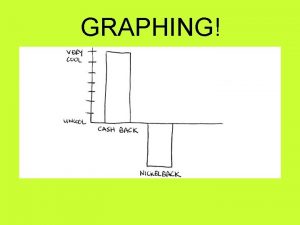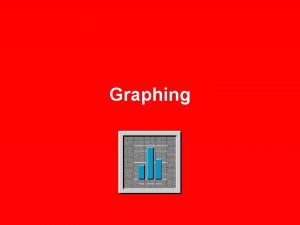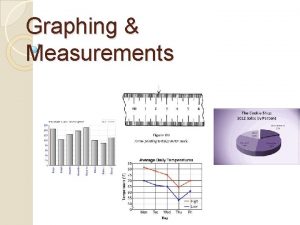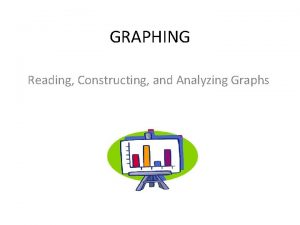GRAPHING NOTES Part 1 TYPES OF GRAPHS Graphs
















- Slides: 16

GRAPHING NOTES Part 1

TYPES OF GRAPHS Graphs are used to illustrate what happens during an experiment. Bar graph - used for comparing data. Pie graph - used to show percentages. Line graph - used to show continuous change, usually change over time.

CREATING A DATA TABLE A data table has 2 columns. The first column is the independent variable. The second column is the dependent variable. INDEPENDENT VARIABLE

Independent Variable This is the factor that we can change. Example: How long thermometer is in the water, or how far the runner races.

Dependent Variable These are the results we get. Example: The water temperature, or how fast the runner ran.

Variable & Controlled Parameters Controlled parameters are the factors that stay constant during the experiment. Example: The amount of salt used or the material used. Variable Parameters are factors that change during the experiment. Example: The mass or volume of the gummy bear in water.

Creating a Graph Data tables help you organize data. Graphs help you understand use data.

AXES An axis is a line that forms one side of the graph. X-axis: the horizontal line that represents the independent variable. Y-axis: the vertical line that represents the dependent variable.

Range & Scale To find the range of each axis, subtract the smallest value on the data table from the largest value. Scale: Each axis has its own scale, or how many spaces between numbers.

Data Points You plot the data points by putting a dot on the graph for each pair of data on the data table.

Labels Title: The title tells people what the graph describes. Do NOT use the word graph in your title. Label axes: Also label the x-axis and y-axis. Include the name and unit label if necessary, like “distance (m)” or “time (sec. )”.

STEPS FOR MAKING A GRAPH ALWAYS USE A RULER! ALWAYS MAKE AS LARGE AS POSSIBLE! 1) Draw the x and y axes. 2) Label the axes. Include units if needed. 1 st column of data table = x-axis 2 nd column of data table = y-axis 3) Decide - line graph or bar graph? 4) Choose a scale and fill in numbers. 5) Plot your data. 6) Write a title for your graph.



Remember To Check For: T Title L Labels U Units D Data

LET’S TRY IT!
 Inequality in two variables
Inequality in two variables Graphing absolute value inequalities
Graphing absolute value inequalities 7 radical din 5
7 radical din 5 Testability tips in software testing
Testability tips in software testing Speed and velocity
Speed and velocity Graphs that enlighten and graphs that deceive
Graphs that enlighten and graphs that deceive End behavior chart
End behavior chart Conversion notes brutes en notes standard wisc 5
Conversion notes brutes en notes standard wisc 5 Fahrenheit 451 dystopia
Fahrenheit 451 dystopia Part part whole addition
Part part whole addition Unit ratio definition
Unit ratio definition Part part whole
Part part whole Technical description examples
Technical description examples Parts of cocktail bar
Parts of cocktail bar The phase of the moon you see depends on ______.
The phase of the moon you see depends on ______. Minitab adalah
Minitab adalah Different types of graph
Different types of graph
















